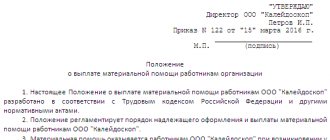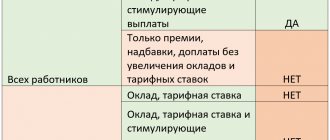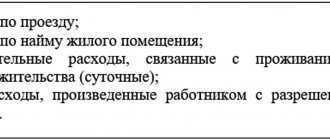What are the mistakes when calculating vacation pay?
Errors in calculating vacation pay are common.
This is explained by the peculiarities of calculating vacation payments associated with determining the average daily earnings. The complexity of the formula and various nuances in determining indicators for it are the main reason that in practice an accountant misses something and receives an error in the amount of vacation pay. Conventionally, the causes of errors can be grouped into the following groups:
- The period included in the calculation is incorrectly defined. For example, the calculation included the time spent by the employee on sick leave, or downtime due to the fault of the employer. The opposite version of the error is also possible - when the calculation did not take into account the days that should fall there.
- The income included in the calculation is incorrectly determined. For example, it included one-time incentive payments (not provided for by the local wage system) or financial assistance. This error also has a reverse version. For example, accountants often do not include one-time remunerations based on the results of work for the year or for length of service in the calculation of average earnings, although such amounts as a general rule should be included (clause 15 of Regulation No. 922, approved by Decree of the Government of Russia dated December 24, 2007).
- Technical errors. Such errors are the downside of automating the accounting process. At the moment of counting, something went wrong, and they saw the error later.
Summarizing the above, we can conclude that, for the purpose of correcting errors in the calculation of vacation pay, they can be divided into two groups:
- errors that led to underpayment of vacation pay and related taxes;
- mistakes that led to overpayment of vacation pay and taxes on them.
The procedure for correction will depend on whether the vacation pay was initially accrued more or less than needed.
A labor inspector in the Nizhny Novgorod region answered individual questions from taxpayers related to the error in granting leave. V. I. Neklyudov. Find out the opinion of the official at ConsultantPlus.
If you do not have access to the K+ system, get demo access for free.
Important "vacation" questions. Dangerous mistakes
Elmira Bagautdinova
Practicing expert, tax consultant, full member of the Chamber of Tax Consultants of Russia, certified teacher of IPB and PNK of Russia, MBA programs at Ulyanovsk State Technical University
EMPLOYERS' RESPONSIBILITY
Employers, including individual entrepreneurs, must provide leave to their employees working under an employment contract. This obligation is established by the Labor Code of the Russian Federation. For failure to comply, labor inspectors may fine an organization from 30,000 to 50,000 rubles, and officials from 1,000 to 5,000 rubles. (Part 1 of Article 5.27 of the Code of Administrative Offenses of the Russian Federation).
RULES AND PROCEDURES FOR PROVIDING ANNUAL LEAVES
The procedure for registering vacations and calculating vacation pay amounts in 2021 has not changed:
- An employee becomes entitled to leave after 6 months of continuous work. But by agreement of the parties, it is possible to send the employee to rest earlier
- The vacation schedule is mandatory for both the employee and the employer. When taking leave unscheduled, the employee submits an application to the employer and waits for a decision. The legislation specifies cases when an employer provides an employee with leave at a time convenient for him (Articles 123, 122, 267, 186 of the Labor Code of the Russian Federation, etc.)
- It is not necessary to take an application from an employee for scheduled leave. A notice of the start of the vacation, which the employee will read and sign, will be sufficient. An exception is if the employee goes on vacation outside of the schedule. Then he should write a statement, including if a vacation is taken by a new employee who was hired after the schedule was approved
- An employee’s refusal to go on vacation as scheduled may result in him being subject to disciplinary action. An employer’s refusal to provide an employee with vacation as scheduled will result in administrative liability
- 2 weeks before the start of the vacation, you need to draw up a vacation order (the employee gets acquainted with it under signature) and draw up a calculation note in which vacation payments are calculated
- The employer is obliged to pay vacation pay 3 calendar days before the start date of the vacation. In this case, it is necessary to take into account both working and non-working days – holidays and weekends. However, the legislation does not prohibit issuing money earlier
REMINDER : Despite the fact that there was a bill to change the procedure for paying vacation pay, it has not yet been adopted. Therefore, when paying, you must be guided by Art. 136 of the Labor Code of the Russian Federation and letters from the Ministry of Labor
HOW TO CALCULATE HOLIDAY PAY FOR AN EMPLOYEE
To do this, you need to determine the duration of the billing period, the employee’s earnings for the billing period, the average daily earnings (ADW) and the total amount of vacation pay in accordance with Article 139 of the Labor Code of the Russian Federation and the Regulations on the specifics of the procedure for calculating the average salary, approved by Decree of the Government of the Russian Federation dated December 24. 2007 No. 922.
For vacation pay and compensation for unused vacation, SDZ is calculated for 12 calendar months. In a situation where the payroll period has been fully worked out, the accrued wages, including all payments provided for in the organization, must be divided into 12 (months) and 29.3 (average monthly number of calendar days). The specifics of calculating vacation amounts if the billing period has not been fully worked out are established by Regulation No. 922.
REMINDER : The calculation period for vacation pay is 12 months preceding the month in which the employee goes on vacation
ERRORS IN CALCULATING HOLIDAY PAY
Such mistakes can lead to disputes not only with employees. If you underestimate the payment, you may be fined by the labor inspectorate. And during the audit, tax authorities will charge additional income tax if the organization overestimated the amount of vacation pay or reflected it in the wrong month. The error must be corrected in a timely manner. If the tax authorities find an error in the income tax return for the year, under the single tax under the simplified tax system, they have the right to charge both penalties and fines.
Common mistakes in tax accounting:
1. The organization took into account vacation pay in the month of issue. Vacation pay must be included in expenses in the month to which the vacation relates. For example, if vacation pay was issued at the end of June, and vacation begins on July 1 (beginning of the 3rd quarter), payment for vacation must be taken into account in July expenses.
2. The employee was given extra vacation pay. First, they need to be excluded from expenses. Secondly, establish the reason for the overpayment (the vacation period was incorrectly determined, excess payments were included in the average earnings). Overpayment is withheld only with the written consent of the vacationer.
REMINDER : You can withhold overpaid vacation pay in one case - if the error arose due to “arithmetic”. This is established by Part 2 of Art. 137 Labor Code of the Russian Federation. There is also a letter from Rostrud dated October 1, 2012 No. 1286-6-1.
3. The employee took his vacation in advance. This allows you to do the norm of Part 2.4 of Art. 122 Labor Code of the Russian Federation. Upon dismissal, the organization has the right to withhold excess vacation pay, but not more than 20% of the salary paid upon dismissal. The employee can only repay the remaining debt voluntarily. Amounts withheld should be included in income. And the remaining debt is included in income either on the day when the employee repaid it voluntarily, or on the day of dismissal, regardless of whether the money was returned or not. Recommendations were given by the Russian Ministry of Finance.
4. The calculation of vacation pay takes into account remuneration under the contract. This payment is not included in the organization’s remuneration (clause 2 of Regulation No. 922).
5. The salary for part-time working time was recalculated to full-time. As a result, the amount of vacation pay is overestimated. If an employee worked part-time during the billing period, then when calculating vacation pay, the salary is taken into account “in fact”. There is no need to recalculate the accounted payments (clause 12 of Regulation No. 922).
6. The calculation takes into account the indexation of the salary of one employee. When calculating vacation amounts, salary indexation is taken into account if it applies to all employees of the organization or division (clause 16 of Regulation No. 922). An increase in salary for one employee is not taken into account.
7. Additional payment of vacation pay was made taking into account the quarterly bonus, which was accrued after the vacation. Vacation pay is recalculated and paid extra only if the employee received an annual bonus for the previous year, for example, in 2021 for 2021 (clause 15 of Regulation No. 922). Quarterly bonuses accrued within the billing period are taken into account when calculating vacation pay. If the quarterly bonus was accrued after a vacation or before going on vacation, but after the end of the billing period, vacation pay is not recalculated and is not paid additionally (clause 15 of Regulation No. 922).
8. Carryover vacation pay is recognized in the month of accrual. The opinion of the Russian Ministry of Finance has not changed (letter dated October 25, 2016 No. 03-03-06/2/62147). If the vacation began in one quarter and ends in the next, it is necessary to divide the total amount of vacation pay between periods in proportion to the days of rest. Include in expenses the amount that relates to this quarter.
REMINDER : The Federal Tax Service of Russia has the opposite opinion. She is not against recognizing expenses for rolling vacation at a time in the month when the organization accrued vacation pay (letter dated March 6, 2015 No. 7-3-04/614). The Federal Tax Service did not include this only letter in the list of explanations on its website that are mandatory for local tax authorities. The explanations of the Ministry of Finance and the Federal Tax Service are contradictory. Therefore, the chosen option should be specified in the accounting policy for tax purposes. However, risks remain
9. Insurance premiums from carryover vacation pay were distributed between months. Insurance premiums from carryover vacation pay do not need to be distributed between the quarters in which the vacation occurred. The amount of contributions should be taken into account in tax expenses on the date of accrual (clause 1, clause 1, article 264 of the Tax Code of the Russian Federation).
FAQ
– Should non-working holidays be included in the duration of vacation?
No no need. When calculating the duration of vacation, exclude non-working holidays from the calculation: both federal (specified in Article 112 of the Labor Code of the Russian Federation) and regional.
– What is the duration of the annual main leave of an external part-time worker?
28 calendar days. Despite the fact that external part-time workers work part-time, they can take vacation on a general basis.
– When an employee goes on vacation, is it necessary to register a combination for his position? If an employer does not pay extra, is this a violation?
While an employee is on vacation, combinations are permitted with the written consent of the other employee. An order must be drawn up indicating what work is being performed on a part-time basis, its duration and the amount of additional payments for the combination. Failure to pay additionally is a violation.
– Is it possible to replace vacation with monetary compensation?
Upon dismissal. If the employee continues to work, then compensation is allowed to replace that part that exceeds 28 calendar days - this is additional or extended leave (Article 126 of the Labor Code of the Russian Federation). For example, workers employed in hazardous industries, with irregular working hours, etc. (Article 116 of the Labor Code of the Russian Federation).
– Should I pay compensation for unused vacation upon dismissal for the period when the employee was sick?
Yes. The length of service that gives the right to basic paid leave includes the time when the employee did not actually work, but according to the law, his place was retained.
– Is it possible to fire an employee during vacation on his initiative?
Yes, you can. An employee has the right to resign at his own request and during absence from work. For example, while on vacation or sick leave.
– Is it necessary to count vacation pay if the entrepreneur himself goes on vacation?
No. Only hired workers have the right to annual paid leave (Article 114 of the Labor Code of the Russian Federation). The individual entrepreneur is not in an employment relationship. Therefore, you do not need to take out your vacation and accrue vacation pay.
Other materials by the author:
Reporting for the first half of 2021: we do not make mistakes
Despite the changeability of the weather, the next reporting campaign begins in July. The risks of making mistakes both when calculating taxes and when filling out declarations and calculations have increased. Reporting has not decreased, as the Federal Tax Service tried to convince. We present answers to questions that arise in practice.
Business fragmentation: what to pay attention to
Due to the use of business splitting schemes by companies during tax audits, organizations are charged additional income tax, VAT, fines, and penalties. They are also accused of illegal use of special regimes. The number of tax disputes and courts is growing every year. Is business “disengagement” a necessity or an illegal scheme?
Tax administration in 2021: what businesses should know
The year 2021 is revolutionary and anniversary. There is a lot of good news in the economy. But if we evaluate the laws adopted concerning business and their number, the situation here is not always joyful. The state believes that in order to restore order, total control should be established over every step of the business, with tougher penalties.
General rules for correcting errors in vacation pay
The rules for correcting errors and the procedure for disclosing information about them in accounting and reporting are established in PBU 22/2010 (approved by order of the Ministry of Finance dated June 28, 2010 No. 63n).
According to paragraph 2 of this standard, inaccuracies in calculations are qualified as an incorrect reflection (non-reflection) of the facts of economic activity, that is, as an error.
Errors may be significant or insignificant. This is determined by how the error affected the overall indicators of the reports in which it was included.
Skewed indicators associated with an error in accruing vacation pay to 1 or 2 employees should hardly be considered a significant error.
For minor errors, PBU 22/2010 provides the following correction procedure:
- The error must be corrected (correct accounting entries must be made) in the month in which it was discovered.
- Profit or loss resulting from correction of an error must be reflected as part of other income or expenses of the same period (in which it was corrected).
Error No. 1 The billing period is determined incorrectly
This error may arise as a result of an incorrect interpretation of paragraph 5 of the Regulation on the calculation of average earnings, approved by Decree of the Government of the Russian Federation No. 922 of December 24, 2007 (hereinafter referred to as Regulation No. 922).
It indicates which period must be excluded from the billing period, as well as the amounts accrued for it. To avoid this error, the following are not excluded from the calculation period:
- Downtime caused by the fault of the employee.
- The length of time the employee participated in the strike.
- Absences and absenteeism due to unknown circumstances at the time of calculation.
- Work breaks related to feeding the child.
If there are no-shows or absenteeism in the billing period, for which the reasons have not yet been clarified, then it is not legal to exclude them from the billing period, in accordance with Regulation No. 922, clause 5. This is due to the fact that the employee can provide documents confirming the legality of his absence from the workplace.
How to correct an error when calculating vacation pay upward
An error in vacation pay “plus” for an employee means that:
- The employee received “extra” money.
- An error in vacation pay resulted in an overestimation of personal income tax and contributions.
- The error resulted in an overestimation of expenses taken to reduce the base for profit or other tax, where the base is calculated on the basis of “income minus expenses.”
These three points need to be corrected in accounting and tax accounting.
In accounting, in the month the error was discovered, adjustment entries should be made to reduce the accrued amounts for vacation pay and contributions (reversal).
If an ERSV calculation has already been submitted for incorrect amounts, it is better to submit an update for the previous period. So that the balance of settlements with the Federal Tax Service matches the accounting data. If corrections were made in different months of the same quarter, the clarification may not be submitted. Everything will be taken into account in the quarterly calculation.
Personal income tax that is excessively withheld from an employee can be taken into account to reduce deductions from future payments (we are considering a standard situation when the employee simply went on vacation without subsequent dismissal, maternity leave, etc.).
The main problem with overpayment of vacation pay is that it cannot be withheld back without the employee’s consent. And the reflection of the result of the adjustment in other income or expenses depends on this.
If the employee agrees to the deduction (the consent must be written), then the amount of the overpayment is withheld from the following payments. In this case, no differences in attribution to income (expenses) arise. All “surpluses” are taken into account in the calculations or compensated.
If the employee does not agree to the deduction, then the overpayment of vacation pay will have to be considered as an expense (loss) in accounting and reflected in expenses in the month when the error was discovered. It should be remembered that such expenses cannot be taken into account in tax accounting (there is no economic justification).
Vacation pay in “1C: Salary and HR Management 8” (ed. 3)
Let's look at some examples of some features of reflecting the amounts of accrued vacation pay, personal income tax and insurance contributions in the 1C: Salary and Personnel Management 8 program, edition 3.
Example 1
| The employee has a vacation period from 04/01/2019 to 04/28/2019. Vacation pay was accrued and paid on March 26, 2019. |
In the Vacation document, vacation pay is calculated on average in the amount of RUB 9,556.40. and personal income tax 1,242 rubles. At the same time, the amount of accruals for March has not yet been taken into account, and it is known that the vacation is subject to recalculation in the future. When paying vacation pay on March 26, 2019, personal income tax is withheld, the deadline for its transfer is March 31, 2019. The calendar feature of the first quarter of 2019 is that March 31 falls on a Sunday, therefore, the tax payment deadline is considered to be the next working day - 04/01/2019 (Clause 7, Article 6.1 of the Tax Code of the Russian Federation).
This means that in Section 2 of the 6-NDFL report (approved by order of the Federal Tax Service of Russia dated October 14, 2015 No. ММВ-7-11 / [email protected] ) for the first quarter of 2021, the amount of accrued vacation pay and personal income tax will not be included, but will be reflected in the report for the first half of 2021. Vacation pay will be included in the calculation base for insurance premiums when calculating salaries for March 2021 in the document Calculation of salaries and contributions.
Vacation and accrued insurance premiums are reflected in the report Calculation of insurance premiums (approved by order of the Federal Tax Service of Russia dated October 10, 2016 No. ММВ-7-11 / [email protected] ) for the first quarter of 2021.
To comply with legislative norms for reflecting vacation pay in accounting and tax accounting, it is necessary to take into account vacation pay and contributions from them in March, calculated as part of deferred expenses. To do this, in the Vacation document, on the Additional tab for vacation pay, it is possible to specify the method of reflection in the Account, subconto field (Fig. 1).
Rice. 1. Method of recording vacation pay
The method of reflecting vacation pay specified in the document is displayed in the document Reflection of wages in accounting for March 2021 (Fig. 2).
Rice. 2. Reflection of vacation pay in accounting
In this case, the Period for accepting expenses for the amounts of Annual Leave and insurance premiums accrued on it is established on 04/01/2019. The accrual type for tax accounting (Clause 7, Article 255 of the Tax Code of the Russian Federation) is set in accordance with that specified in the accrual type setting Main vacation on the Taxes, contributions, accounting tab.
As a result of synchronization with the 1C: Accounting 8 program, edition 3.0, the amounts of vacation pay and calculated contributions will be reflected in the corresponding entries in the debit of account 97.01 “Payroll expenses for future periods.”
Example 2
| In continuation of Example 1, the employee’s vacation from 04/01/2019 to 04/28/2019 was canceled on 04/01/2019 due to production needs. Accordingly, there are no grounds for accrual and payment of vacation pay on March 26, 2019. |
Since the payment of vacation pay has already been made, you cannot edit or cancel the posting of the Vacation document. To cancel a vacation, use the Reverse command in the document that accrued the vacation (Fig. 3).
Rice. 3. Cancellation of accrued vacation
As a result of posting the Reversal document in the Tax Accounting Register for Personal Income Tax, the income code is set to “2012”, and the amount accrued in March is RUB 9,556.40. according to this code, it is reflected in April with a minus sign (Fig. 4).
Rice. 4. Tax register for personal income tax
When calculating wages, the salary payment for April will be accrued in full, and the 2-NDFL certificate will not reflect the fact of accrual and cancellation of vacation. Income with the code “2012” in the 2-NDFL certificate will not be registered either in March - with a plus, or in April - with a minus.
However, the perfect fact of paying vacation pay can no longer be undone. This means that the block reflecting this payment in the amount of 9,558.40 rubles on March 26, 2019, tax withholding in the amount of 1,242 rubles. and the deadline for its transfer of 04/01/2019 will remain unchanged in Section 2 of the 6-NDFL report for the half year of 2021.
How to correct a mistake in vacation pay to a lesser extent
How to correct an error in vacation pay in case of underpayment of vacation pay? The procedure is somewhat simpler than described above.
A negative error means that:
- the employee did not receive enough money;
- personal income tax and contributions were underpaid;
- the error resulted in an understatement of expenses taken to reduce the base for profit or other tax, where the base is calculated on the basis of “income minus expenses.”
Additional vacation pay and the deductions due from them must be additionally accrued in accounting in the month the error was discovered. You can immediately apply it to other expenses (immediately attributed to account 91).
Clarifications should be made if the ERSV has already been submitted. The amount not paid additionally to the employee and personal income tax to the budget must be paid additionally.
Cheat sheet for calculating salaries, vacation pay and sick leave
The general procedure for calculating payment for annual leave provides that the average salary for vacation pay is calculated for the last twelve months by dividing the total income for this period by the amount of days worked. There are cases when it is necessary to recalculate payments for various reasons, which sometimes do not depend on the employer.
As a rule, the issue of recalculation arises in the following cases:
- payment of annual bonus next month;
- salary changes;
- recall from annual paid leave;
- illness of an employee while on vacation;
- dismissal of an employee;
- counting error.
This is important to know: Deadlines and rules for applying for leave under the Labor Code
If the employee himself finds out that vacation pay was accrued incorrectly, or the accountant noticed a mistake, then a recalculation must be made without the employee’s application.
Error in vacation pay in 6-NDFL
Is it necessary to correct an error in vacation pay in 6-NDFL if the calculation has already been submitted based on the results of the period with an error?
It turns out there is no need. If an error was made, say, in the second quarter, and was discovered in the third, then the difference will be recalculated in the third. That is, the payment of vacation pay and the recalculation of vacation pay were made on different dates.
Therefore, in 6-NDFL for the third quarter, it is enough for the accountant to show the correct amount of accruals taking into account the corrected vacation pay in section 1 of 6-NDFL and, if there was an additional payment of vacation pay in the third quarter, reflect it in section 2 of 6-NDFL (in lines 100−140) .
Error No. 4. The organization has a billing period of less than 12 months
According to clause 4 of PP No. 922, average earnings are calculated from the salary actually accrued to the employee for the time actually worked during the 12 months before the month of vacation. Article 139 of the Labor Code of the Russian Federation allows the approval of other periods by decision of the employer. The specifics of the calculation must be specified in the enterprise’s LNA or collective agreement. An important condition is that the calculation procedure should not worsen the situation of the personnel.
What to do to avoid mistakes when calculating vacation pay? If the employer’s LNA establishes a different period (not 12 months), you will have to count the amount of vacation payments twice. The first is from the standard 12 months, the second is from the period established in the organization. If the amount of vacation pay accrued according to the first method turns out to be more, you need to pay exactly that.
Results
Errors in calculating vacation pay must be promptly corrected. To do this, you need to reflect changes in accounting and tax accounting, as well as make corrections to the calculation of insurance contributions, 6-NDFL and 4-FSS if an error is identified in the next reporting period.
Sources:
- Labor Code of the Russian Federation
- Decree of the Government of Russia dated December 24, 2007 No. 922
- PBU 22/2010, approved. By Order of the Ministry of Finance of Russia dated June 28, 2010 N 63n
You can find more complete information on the topic in ConsultantPlus. Free trial access to the system for 2 days.
Calculation procedure
When calculating vacation pay, the following points must be taken into account:
- Vacation is provided according to the approved vacation schedule.
- The calculation period takes into account the 12 months preceding the start of the vacation, so, for example, if an employee goes on vacation in June 2021, then the average earnings should be determined for the period from June 2021 to May 2021;
- The days the employee is on sick leave, on vacation, and days caring for disabled children are excluded from the calculation period for calculating vacation pay.
- If salary indexation took place during the billing period, then vacation pay must also be indexed.
- Personal income tax must be withheld from vacation pay amounts, as well as insurance premiums must be calculated.
- Vacation pay must be paid to the employee three days before the start of the vacation.
When calculating vacation pay, the period worked by the employee must be taken into account. If the employee worked full time, then the formula for calculating vacation pay is as follows:
SZ = SVVR / 12 / 29.3,
where SZ is the average earnings for the 12 calendar months preceding the vacation, SVVR is the amount of payments for the 12 calendar months preceding the vacation included in the calculation.
The amounts that must be taken into account when calculating average earnings are payments that are provided for by the remuneration system, accrued in favor of the employee in the billing period. These include wages, bonuses, allowances, etc. (Article 139 of the Labor Code of the Russian Federation). Along with this, the following are not taken into account in the calculation:
- social and other non-labor payments (travel or utility bills);
- amounts that were received by the employee when he was not working, but in accordance with the law, his average earnings were retained (vacation pay, temporary disability benefits).
When an employee did not work all 12 months or there were excluded days in the period, which were mentioned earlier, other formulas are used to calculate average earnings:
SZ = SVVR / KDOP,
where SZ is the average earnings, SVVR is the amount of payments for the 12 calendar months preceding the vacation included in the calculation, KDOP is the number of days in the period worked.
Determine the number of calendar days in the worked period using the formula:
29.3 * KPOM + OKDNPM,
where KPOM is the number of fully worked months, OKDNPM is the total number of days in incompletely worked months.
Calculate the number of calendar days in incompletely worked months of the billing period as follows:
KODM / CHKDM * 29.3,
where KODM is the number of days worked in a month, CHKDM is the number of calendar days in a month.








